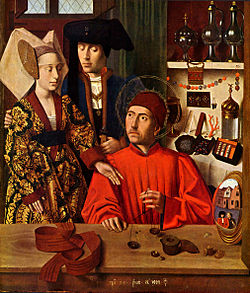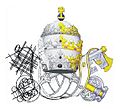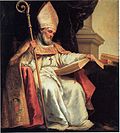Portal:Catholic Church
Introduction The Catholic Church (Latin: Ecclesia Catholica), also known as the Roman Catholic Church, is the largest Christian church, with 1.27 to 1.41 billion baptized Catholics worldwide as of 2025. It is among the world's oldest and largest international institutions and has played a prominent role in the history and development of Western civilization. The Church consists of 24 sui iuris (autonomous) churches, including the Latin Church and 23 Eastern Catholic Churches, which comprise almost 3,500 dioceses and eparchies around the world, each overseen by one or more bishops. The pope, who is the bishop of Rome, is the chief pastor of the church. The core beliefs of Catholicism are found in the Nicene Creed. The Catholic Church teaches that it is the one, holy, catholic and apostolic church founded by Jesus Christ in his Great Commission, that its bishops are the successors of Christ's apostles, and that the pope is the successor of Saint Peter, upon whom primacy was conferred by Jesus Christ. It maintains that it practises the original Christian faith taught by the apostles, preserving the faith infallibly through scripture and sacred tradition as authentically interpreted through the magisterium or teaching office of the church. The Roman Rite and others of the Latin Church, the Eastern Catholic liturgies, and communities and societies such as mendicant orders, enclosed monastic orders, third orders and voluntary charitable lay associations reflect a variety of theological and spiritual emphases in the church. Of its seven sacraments, the Eucharist is the principal one, celebrated liturgically in the Mass. The church teaches that through consecration by a priest, the sacramental bread and wine become the body and blood of Christ. The Virgin Mary is venerated as the Mother of God, and Queen of Heaven; she is honoured in dogmas, such as that of her Immaculate Conception, perpetual virginity and assumption into heaven, and devotions. Catholic social teaching emphasizes voluntary support for the sick, the poor, and the afflicted through the corporal and spiritual works of mercy. The Catholic Church operates tens of thousands of Catholic schools, universities and colleges, hospitals and orphanages around the world, and is the largest non-governmental provider of education and health care in the world. Among its other social services are numerous charitable and humanitarian organizations. (Full article...) Selected article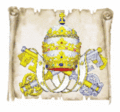
 Seton Hall University is a private Roman Catholic university in South Orange, New Jersey. Founded in 1856 by Archbishop James Roosevelt Bayley, Seton Hall is the oldest diocesan university in the United States.Seton Hall is also the oldest and largest Catholic university in the State of New Jersey. The university is known for its programs in business, law, education, nursing, and diplomacy, as well as its basketball team.Seton Hall is made up of nine different schools and colleges with an undergraduate enrollment of about 5,200 students and a graduate enrollment of about 4,500. Its School of Law, which is ranked as one of the top law schools in the nation, has an enrollment of about 1,200 students. The Seton Hall College of Medicine and Dentistry was acquired by the state in 1965, and is now the New Jersey Medical School, part of the University of Medicine and Dentistry of New Jersey.Like many Catholic universities in the US, Seton Hall arose out of the Plenary Council of American Bishops, held in Baltimore in 1844, with the goal of bringing Catholicism to higher education in order to help propagate the faith.
Selected image
 Credit: Diliff St. Vitus Cathedral (Czech: Katedrála svatého Víta) is a Roman Catholic cathedral in Prague, Czech Republic, and the seat of the Archbishop of Prague. The full name of the cathedral is St. Vitus, St. Wenceslas and St. Adalbert Cathedral. Located within Prague Castle and containing the tombs of many Bohemian kings, this cathedral is an excellent example of Gothic architecture and is the biggest and most important church in the country. Selected biography
 Albin (or Albinus) (d. 1269) was a 13th-century prelate of the Kingdom of Scotland. A university graduate, Albin is known for his ecclesiastical career in the diocese of Brechin, centred on Angus in east-central Scotland. Almost certainly a native of Angus, he appears to be a descendant of David of Scotland, Earl of Huntingdon, brother of King William I of Scotland, through an illegitimate son whom Earl David settled in the area around Brechin. Albin, himself an illegitimate child, made his career as a churchman in the local diocese, and served for some time as precentor of Brechin Cathedral before, in 1246, being elected Bishop of Brechin. He remained Bishop of Brechin until his death in 1269. Albin became Bishop of Brechin following an election and then a successful appeal for confirmation to the papacy. Pope Innocent IV's mandate for confirmation gave the details of the election.
Did you know...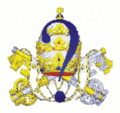
Related portalsFeast Day of December 1
Born into a Gallo-Roman family, Eligius found success as a goldsmith at the Merovingian royal court of Clotaire II and served as chief counsellor to Dagobert I until Dagobert's death in 639. Under the subsequent regency of Nanthild, the queen consort, Eligius was ordained a priest and campaigned against simony in the Church. Appointed Bishop of Noyon–Tournai in 642, he founded many monasteries and churches while working to convert the pagan population of Flanders to Christianity. (Full article...)
Selected quote

News
SubcategoriesTopics
The Holy Bible:
Particular churches (grouped by liturgical rite):
Things you can do
External resourcesWikiProjectsAssociated WikimediaThe following Wikimedia Foundation sister projects provide more on this subject:
Discover Wikipedia using portals |



